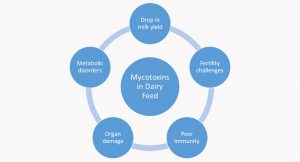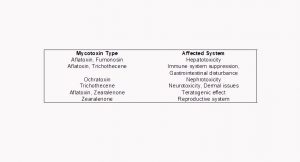 Feb 1,2020
Feb 1,2020

A recent study on feed ingredients covering 75 countries has revealed that 84% of samples contained at least one mycotoxin and over 50% samples are contaminated with more than one mycotoxin. The study marked South East Asia in a high threat zone. These feed ingredients when fed to animals cause production and health losses in dairy animals. Also, mycotoxins are secreted in milk and this poses a major health risk to humans.
For dairy farmers, mycotoxins are nowadays an important area of concern. Climatic conditions in India favour the frequent development of fungi in feed grains leading to production of mycotoxins. Many times storage conditions also create an environment for fungal growth.
With increasing production cost of milk and high value of dairy animals, any drop in production or deterioration in animal’s health can negatively impact the economics of dairy farming.
Ruminal disturbances
Mycotoxins affect the rumen microbial population because of their antimicrobial, antifungal and antiprotozoal properties leading to digestive disorders in ruminants, which ultimately lead to loss of production and poor health.
Fertility related issues in dairy animals
Zearalenone has a structural similarity to the female reproductive hormone estradiol and it activates estrogen receptors in the body. Zearalenone is a metabolite of several species of Fusarium and it can be found in silage, which is now a days practiced in many parts of India. Feed stuffs like corn, soybean, wheat, barley, oats, sorghum and hay are major sources of this mycotoxin.
Effects of Zearalenone toxicity are impaired heat and abortion.
Damage to vital organs
Aflatoxins are hepatotoxic while Ochratoxins are nephrotoxic in nature. Damage to these important vital organs lead to severe health issues and loss of production. High dose of such mycotoxins can have a lethal effect on animals.
Metabolic Disorders
Mycotoxins in dairy feed may lead to ketosis, abomasal displacement, mastitis, metritis, lameness and increased somatic cell count (SCC).
Poor Immunity
Aflatoxins suppress the immune function in dairy animals making them more prone to diseases. Dairy farmers have to spend a lot of money on treatment of animals in addition to the loss due to decreased production.

Other concerns associated with mycotoxins in dairy feed are increased risk of retained placenta, reduced appetite, general unthrifty appearance, intermittent diarrhea and rough hair coat.

Mycotoxins in Milk:
As growing concern over food safety makes headlines nowadays, milk that is an integral part of our diet becomes a point of focus.
1.7% of dietary Aflatoxin intake is excreted in milk within 12 hours as Aflatoxin M1 (AfM1).
FDA limit for Aflatoxin M1 in milk is 0.5 ppb.
Impact on human health:
Aflatoxins have shown carcinogenic effect in susceptible laboratory animals and they produce acute toxicological effects in humans.

Control of mycotoxins requires a multi-pronged approach as studies indicate that most of the time there is more than one mycotoxin in feed. Avitech’s expertise in dairy nutrition has led to development of a breakthrough solution which is able to control various mycotoxins.
Avsorb Forte is the answer to multiple mycotoxin challenges in dairy feed. Avsorb Forte has been formulated with selected ingredients like Calcium montmorillonite, Activated carbon and Organic acids.
Calcium Montmorillonite possesses a characteristic 2:1 layer structure that has a capacity to adsorb and absorb 15 times more than widely used clays. It has a standard porosity of 3-8 Angstrom so it does not bind with vitamins and minerals. It has a MB value of more than 350 that ensures higher binding efficiency. Calcium Montmorillonite also exhibits bactericidal properties.
Activated carbon is an antidote for acute exposure to several mycotoxins. Different grades of activated charcoal have variable effects in adsorbing mycotoxins and other toxins like chemicals and pesticides. The activated carbon incorporated in Avsorb Forte, is of pharmaceutical grade with particle size of 200 mesh. It has a MB index of more than 250 mg/g which indicates a mesoporosity to enable adsorption of mycotoxins effectively.
Organic acids present in Avsorb Forte impart an inhibitory effect on mold growth and reduce further production of mycotoxins in cattle feed.
Monsoons represent a high risk season for mycotoxins to develop in feed. By adding Avsorb Forte to dairy feeds, dairy farmers can prevent various losses occurring due to loss of production and poor health of animal.